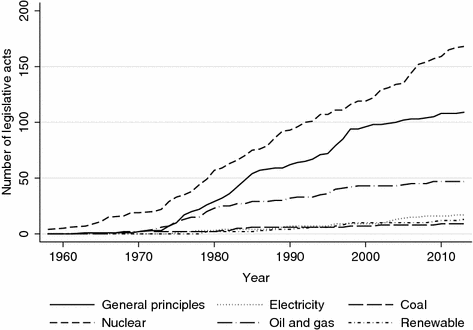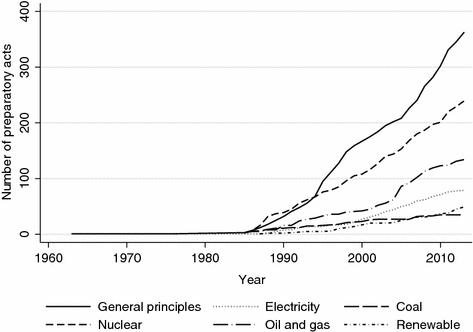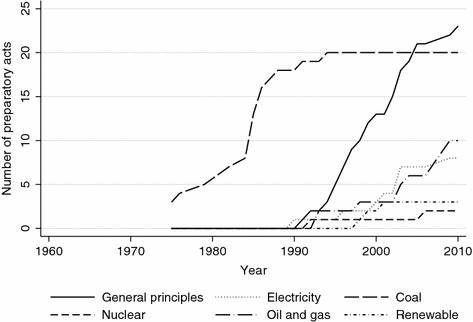The EU’s Energy Policy Agenda: Directions and Developments

First stage
Second stage
Third stage
Time frame
Mid-1950s to late 1980s
Late 1980s to mid-2000s
Since mid-2000s
Legal framework
• European Coal and Steel Community (1951)
• Single European Act (1987)
• Treaty of Lisbon (2007)
• Atomic Energy Community (1957)
• Treaty of Maastricht (1992)
Focus of EU energy policy
• Energy security
• Environmental policy integration (EPI) principle
• Functioning of energy markets
• Common market
• Energy as a priority matter
• Energy supply
• Energy efficiency
• Renewable energy
• Interconnection of energy networks
On top of these changes and following a regulation of the EP and the Council in 2011, European citizens have been given the possibility to submit citizens’ initiatives—a right that was granted to them by the Treaty on EU and the Treaty of Lisbon. Since spring 2012, a total of 13 successful or open initiatives have been registered with the goal to request the Commission to initiate or adjust legislation on different topics.1 The European Citizens’ Initiative enables the public to shape the Commission’s and hence the EU’s overall political agenda also but not only in terms of energy policy. In August 2012, a citizens’ initiative was started to suspend the 2009 “Energy and Climate Change” package of the EU hence moving this issue again from the systemic to the political agenda of the Commission (Cobb and Elder 1972, 1991; Cobb et al. 1976).
2.3 The Evolvement of Energy Policy Agendas in EU Institutions
Changing institutional and legal conditions over the last six decades have led to evolving agenda-shaping and decision-making processes in different EU institutions. In order to illustrate the developments in attention for energy issues, this section will provide a descriptive account of the amount of official documents issued in the context of these processes. On the one hand, I assume the degree of attention and decision-making activity for certain issues to be reflected in the number of legislative documents in force on the different dimensions of energy policy. On the other hand, there are also situations, in which political attention for certain issues does not last beyond the agenda-setting stage of an institution either because agenda setting is unsuccessful and the issue is dropped altogether from the agenda or because the issue is being delegated to other institutions for further decision making. In order to address these cases, the analysis also includes the number of preparatory documents on the different energy topics issued by EU institutions over time.
I look at the developments in the issuance of preparatory and legal documents in two different European decision-making bodies, which are the Commission and the Council of Ministers (or Council). Such a perspective seems fruitful as it allows me to compare two institutions that have repeatedly been the target for delegated action in energy policy by the European Council (see Chap. 3 by Alexandrova and Timmermans). Moreover, it allows for comparing the institution with the formal monopoly for agenda setting (the Commission) with an institution that has contingent or indirect agenda setting powers (the Council) through its ability to request legislative initiatives from the Commission.
The following sections assess how and at what pace the overall degree of agenda activity has evolved over time in the two institutions. In this context, I compare regulation and agenda shaping surrounding different dimensions of energy policy (i.e. general principles, electricity as well as coal, oil and gas, nuclear energy or renewable energy) in the Commission and the Council. This prepares the ground for the subsequent section, in which I take an in-depth look at the agenda-shaping cascade in European institutions following the European Council meeting in Hampton Court in 2005 and in the wake of the Treaty of Lisbon.
2.3.1 The Energy Policy Agenda of the Commission
In order to understand agenda-shaping priorities in energy policy in the EU, the following paragraphs compare the development in the number of preparatory acts and legislative documents for different issues of energy policy over the last decades. Figures 2.1 and 2.2 graphically depict how “densely” energy production from different sources (coal, nuclear, oil, gas, renewables, etc.) has been addressed in the Commission from 1960 to 2010 (see Knill et al. 2011 for an overview of conceptual alternatives for measuring policy change). They also approximate the role that internal market considerations have played over time (e.g. through the regulation of the electricity market) and how often general principles and programmes were subject to the agenda-shaping or decision-making processes. The figures illustrate the cumulative number of documents (that is preparatory acts and legislative documents respectively). They do not report the content, bindingness, extent or the number of issues addressed in the different provisions. Therefore, the counts can only serve as rough proxies for the development in attention and regulation over time. Furthermore, the comparison between the two figures (preparatory versus legislative documents) allows for assessing if issues that have been on the agenda actually translate into concrete regulation.



Fig. 2.1
Number of preparatory acts on energy issued by the Commission. Source Own illustration based on EUR-Lex (2013)

Fig. 2.2
Number of legislative acts on energy issued by the Commission. Source Own illustration based on EUR-Lex (2013)
Attention in the Commission has been traditionally high with regard to general principles and programmes in energy policy (Fig. 2.1). Since the mid-1980s, the energy policy agenda of the Commission has constantly dealt with overall objectives of EU energy policy. Nevertheless, political attention has often not translated into concrete policy decisions (Fig. 2.2), which is in part explained by limited decision-making competencies of the Commission in this area. Another focus of the Commission’s preparatory documents has been on the regulation of nuclear energy based on the Euratom treaty. In this context, the Commission has repeatedly brought the issue (nuclear energy) also back to the Council’s policy agenda by proposing Council decisions or by reporting on past activities in this area of regulation. In fact, several attempts have been made in the Commission to shape the Council’s agenda and to encourage legislative action (through proposals, draft regulations or directives, communications as well as green papers and reports). This is also true for the Commission’s agenda in the area of oil and gas—at least as it concerns the years from 1985 to the mid-1990s. During this period, most of the preparatory acts were directed to the Council with the explicit request to address certain issues related to the regulation of oil and gas in the EU. These agenda-shaping activities were successful if we look at the Council’s legislative record in these areas (see Fig. 2.4).
However, also the Commission’s policy agenda has also been shaped by the political agendas of other EU bodies. Since the mid-1990s, the European Council has increasingly requested the Commission to regulate energy matters by means of delegated action (see Alexandrova and Timmermans in Chap. 3). As the case studies of this volume illustrate, the Commission has prioritised certain energy issues over others, which is why the success of these requests in terms of concrete policy outputs varies over issues.
The policy priorities are broadly reflected in the Commission’s legislative activity with regard to energy policy (see Fig. 2.2). As outlined above, regulation in the area of coal usually took the form of approving aids from different member states to the national coal-mining industry, which were usually granted for a period of one year. Since the turn of the millennium, activity in this area has stopped altogether. In line with the Commission’s agenda, much regulation was also passed in the area of nuclear energy. This has come in the form of Commission Decisions but also Commission Opinions with respect to national policy decisions in this area (e.g. on decommissioning or dismantling of nuclear facilities in member states or the disposal of radioactive waste).
Finally, especially since the mid-2000s, the Commission has increasingly become involved in the regulation of general principles and programmes in the energy sector. This may be due to the increasing complexity of energy policy, technological progress and the diversification of energy generation. This finding also reflects the complex interrelationship between energy, climate and environmental policy making, which has not sufficiently been addressed by past legislation. All in all, it shows how the framing of energy policy as a horizontal policy issue (Egenhofer et al. 2011) has increased the perceived need of policy actors for a coherent approach in EU energy policy. Altogether, the broad overview of agenda shaping and decision making illustrates that the development of a comprehensive EU energy policy has gradually become a priority on the Commission’s energy policy agenda in times of growing environmental challenges (Oberthür and Pallemaerts 2010; Schmitt and Schulze 2011; Solorio 2011).
2.3.2 The Energy Policy Agenda of the Council
The picture is slightly different for the Council. Figure 2.3 shows that attention in the Council has changed over time. From 1975 to 1990 the Council mainly published preparatory acts on energy generation based on coal. By issuing a number of assents, it empowered the Commission to grant support to the European coal industry or to support research in this area. The Council hence directly structured the Commission’s policy agenda and regulatory activity with regard to energy production from fossil fuels (i.e. coal, see Fig. 2.2).


Fig. 2.3
Number of preparatory acts on energy issued by the Council of the EU. Source own illustration based on EUR-Lex (2013)
The picture became more diverse in the beginning of the 1990s. The Treaty of Maastricht (1992) meant a diversification in the Council’s approach towards energy policy in the EU. From then on, the design of general principles and programmes became more important and has influenced the energy debate in the Council until today. This is reflected in different publications of Council positions on a number of issues such as energy networks, energy mix, the role of different sources therein and energy efficiency. In addition, internal market considerations (electricity) and external energy relations (oil and gas) have repeatedly been on the Council’s policy agenda since the mid-1990s, which was in part prompted by the Commission.
This picture roughly corresponds to the actual regulatory activity in the Council. Apart from Euratom’s activities in regulating nuclear energy provisions and structures in the EU, the Council has mainly and constantly acted to specify the broad lines of energy policy (general principles and programmes, see Fig. 2.4).


Fig. 2.4
Number of legislative acts on energy issued by the Council of the EU. Source own illustration based on EUR-Lex (2013)
Moreover, policy making in Council reflects the energy policy agenda of the European Council (i.e. the heads of state or government of the member states), which is also due to the institutional linkage of the two EU bodies. Until the early 2000s, the Council was the main target for delegated action in energy policy by the European Council (see Alexandrova and Timmermans in Chap. 3). By means of mostly recommendations, resolutions, directives and decisions, the Council has therefore worked among other things on an energy policy strategy for the EU, financial issues as well as research and demonstration projects. Since the mid-1990s, a number of these policies on general principles have been developed in cooperation with the EP based on the co-decision procedure that was introduced by the Treaty of Maastricht. Another area of regulatory involvement of the Council is external energy relations and internal market issues with regard to the provision with oil and gas. Due to the EU’s import dependency in this area, most of the initiatives regulate external trade and internal market aspects with regard to energy production from and imports of oil and gas. Compared to these fields of action, the Council has paid relatively little but even attention to the regulation of the remaining aspects of energy policy (that is coal, electricity and renewable energy).
This section illustrated patterns of EU agenda shaping and regulation in two institutions—the Commission and the Council. Agenda-shaping dynamics were roughly approximated with the number of preparatory acts for a given issue. The number of legislative acts was used to reflect the priority of regulation and the legal competences to do so. By focusing on the field of energy policy only, the figures do not allow for any conclusions with regard to the relative attention that is paid to the area of energy policy as compared to other fields of regulation (but see Alexandrova and Timmermans in Chap. 3 for an assessment of the distribution of attention over different policy fields in the European Council).
The broad lines of agenda shaping and decision making as illustrated in Figs. 2.1, 2.2, 2.3 and 2.4 allow for different conclusions. First, they show that agenda shaping in an institution usually corresponds to the overall subsequent regulatory or legislative output. Second, they draw the overall changes in EU energy policy as a consequence of technological developments, different priorities and changing policy problems. Third, there is also evidence for inter-institutional dynamics (i.e. the transfer of attention and priorities), which will be explored in more detail in the next section. Finally, the figures showed that the idea to fundamentally adjust or develop EU energy policy has increasingly been on the political agenda of both the Commission and the Council (but also of other European institutions). This pattern suggests that the idea to develop a comprehensive EU energy policy was not motivated exclusively by external factors or events but that it was also promoted from within EU institutions (see also Princen 2007, p. 24ff).
2.4 Patterns of Inter-institutional Agenda Shaping and the Emergence of a Comprehensive EU Energy Policy
The previous sections showed that agenda shaping and energy policy making in different areas were for a long time singular and constituted rather a series of single decisions. This is for instance true for the EU’s regulatory approaches in the areas of nuclear energy (see Egenhofer and Behrens 2011). These developments reflect the structural and institutional conditions in which the decisions were made. Notwithstanding, as outlined in Sect. 2.2, energy policy has increasingly become a policy field on its own with strong links to neighbouring fields such as environmental, climate or technological policy. As a result since the mid-2000s, European institutions and actors have worked towards the development of a comprehensive European energy policy (or the EU energy union), which had been on the political agenda of different EU institutions for a while (see Sect. 2.3). An approach was needed to adequately accommodate current challenges in the generation, use and distribution of energy by incorporating developments in related areas of regulation such as climate, environment, technology and research. The following subsections shed light on this process. The subsequent part 2.4.1 identifies the structural determinants of agenda shaping. Section 2.4.2